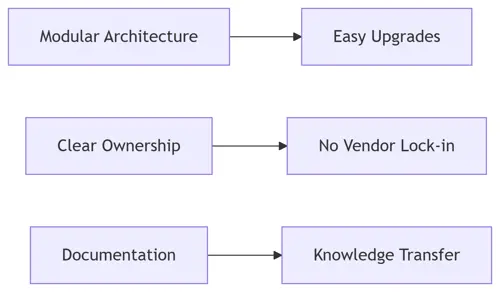Protect your investment and avoid costly failures. These 9 strategic questions help non-technical leaders evaluate .NET Core + React development partners for long-term success.
Protect your investment and avoid costly failures. These 9 strategic questions help non-technical leaders evaluate .NET Core + React development partners for long-term success.
When a Fortune 500 retailer selected a "top-rated" agency for their inventory system modernization, the decision seemed sound - until it cost them $2.8M in losses and 14 months of delays. The root causes? Fundamental gaps that executives couldn't see during vendor evaluation:
"We discovered 92% of technical failures originate from vendor selection missteps - not coding errors."
After rescuing some of such projects through our specialized .NET Core and React Development Services, we've transformed hard-won lessons into 9 strategic questions that protect your capital and reputation. These questions have helped clients:
The executive's dilemma: How do you evaluate technical capabilities when you're not a developer? This guide bridges that gap - transforming complex technical concepts into boardroom-ready due diligence.
Why This Matters: 42% of digital initiatives fail due to scalability issues (Gartner 2025).
Business Risks:
Demand Evidence Of:
Financial Exposure: The average breach costs $4.45M (IBM 2025).
Critical Focus Areas:
| Risk Area | Business Impact |
|---|---|
| Data Theft | Regulatory fines + customer trust erosion |
| System Takeover | Operational disruption + ransom payments |
| Compliance Failures | Contract violations + legal liability |
Verify Through:
The Domain Knowledge Gap: Generic tech teams miss critical requirements.
Sector-Specific Red Flags:
| Industry | Unique Needs | Consequences of Failure |
|---|---|---|
| Healthcare | HIPAA compliance | $50k+ fines per violation |
| Finance | PCI-DSS certification | Loss of processing rights |
| Manufacturing | IoT integration | Production line shutdowns |
Require:
The Obsolescence Trap: 60% of custom software requires major rework within 3 years.
Protection Strategies:

Key Deliverables:
Project Failure Rates: 75% of IT projects exceed timelines (Standish Group 2025).
Verify Their Control Framework:
| Process | Business Impact |
|---|---|
| Biweekly Demos | Early issue detection |
| Risk Registers | Proactive problem solving |
| Buffer Budgets | Avoids change order traps |
Red Flag: Fixed-price contracts without flexibility for discovery phases.
Operational Risk: 40% of companies never recover from major IT failures.
Non-Negotiables:
| Requirement | Why It Matters |
|---|---|
| Disaster Recovery | Minimizes downtime costs |
| Geographically Distributed Teams | Prevents single-point failures |
| Security Incident Response SLA | Limits breach impact |
Hidden Cost Alert: Maintenance averages 30% of initial build annually.
Cost Breakdown Demand:
| Phase | % of Budget | CEO Focus Area |
|---|---|---|
| Development | 60% | Feature ROI |
| Testing | 20% | Risk Reduction |
| Maintenance | 20% | Long-term viability |
The Vendor Lock-in Trap: 68% of companies can’t maintain outsourced systems internally.
Prevention Checklist:
Contract Must-Have: Knowledge transfer milestones with acceptance criteria.
The Longevity Test: Anyone can deliver a prototype – partners sustain value.
Questions for References:
Red Flag: Only showcase projects under 12 months old.
Choosing a development partner is a capital allocation decision with 7-figure implications. The right provider becomes a strategic asset who:
"With great technology comes great responsibility – choose partners who share your fiduciary duty."
See our work on a developer mentoring platform that handles high concurrent user loads with a scalable .NET Core backend and responsive React frontend.